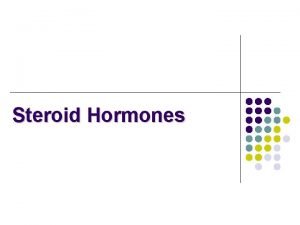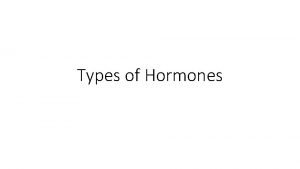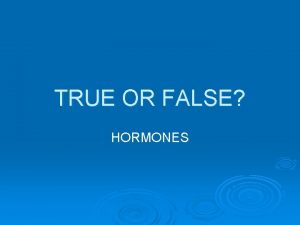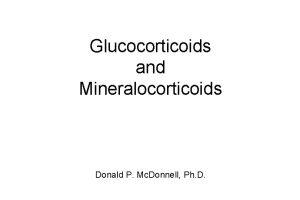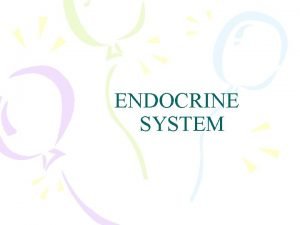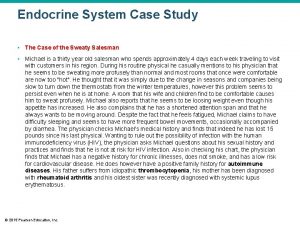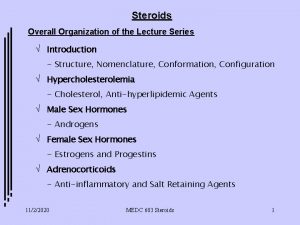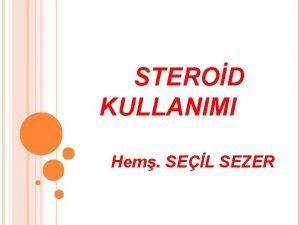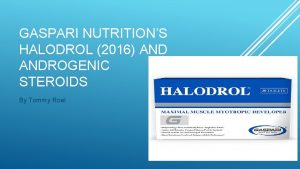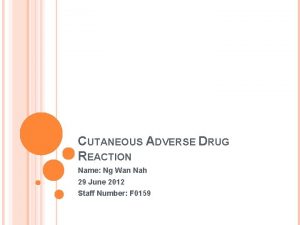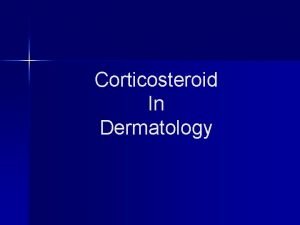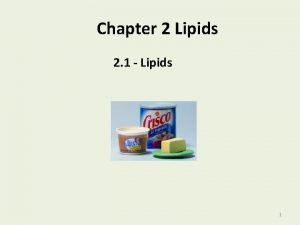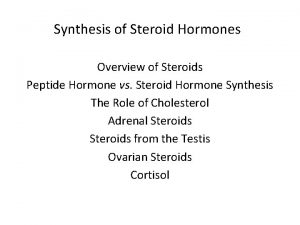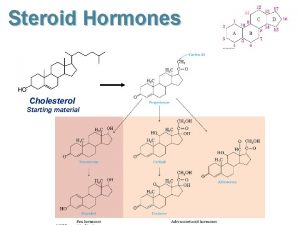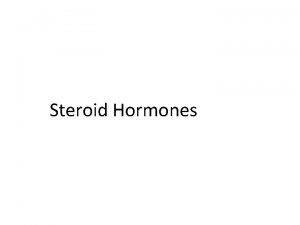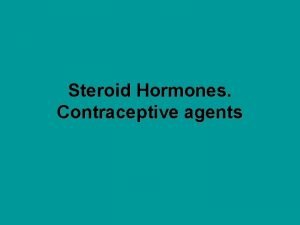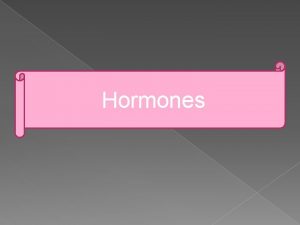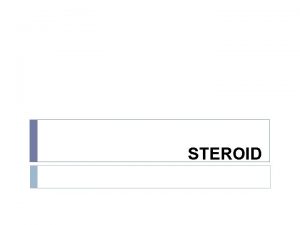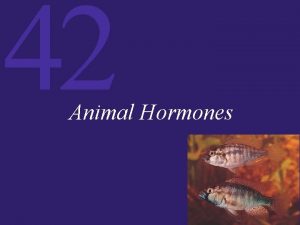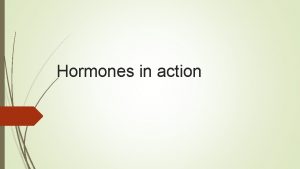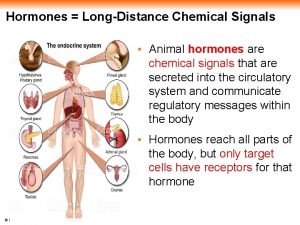Steroid Hormones Chemical Classification of Hormones are chemical















- Slides: 15

Steroid Hormones

Chemical Classification of Hormones are chemical messengers that transport signals from one cell to another There are 4 major chemical classes of hormones • • steroid hormones - i. e. progesterone peptide hormones - i. e. insulin amino acid derivatives - epinephrine prostaglandins and related compounds

Mechanism of Hormone Action All hormone action is receptor mediated 1. Peptide hormones and catecholamines bind to cell surface receptors 2. Steroid and thyroid hormones act via intracellular receptors

Structure of Steroid Hormones Steroids are lipophilic molecules. All steroids, except calcitriol, have cyclopentanoperhydrophenanthrene structure (sterane). The parental precursor of steroids - cholesterol

Steroid Hormone Classes Progestins Glucocorticoids Mineralocorticoids Androgens Estrogens Vitamin D

Steroid Hormones l l Are not packaged, but synthesized and immediately released. Are all derived from the same parent compound: cholesterol. Enzymes which produce steroid hormones from cholesterol are located in mitochondria and smooth Endoplasmic Reticulum. Steroids are lipid soluble and thus are freely permeable to membranes so are not stored in cells.

Steroid Hormones l l Are not water soluble so have to be carried in the blood complexed to specific binding globulins. Corticosteroid binding globulin carries cortisol. Sex steroid binding globulin carries testosterone and estradiol. In some cases a steroid is secreted by one cell and is converted to the active steroid by the target cell: (androgen is secreted by the gonad and converted into estrogen in the brain).

Steroid hormones l Steroid hormones play important roles in: - carbohydrate regulation (glucocorticoids) - mineral balance (mineralocorticoids) - reproductive functions (gonadal steroids) l Steroids also play roles in inflammatory responses, stress responses, bone metabolism, cardiovascular fitness, behavior, cognition, and mood.

Steroid Hormones Adrenal cortex • Composed of 3 layers (zones): • outer zone (zona glomerulosa) produces aldosterone (mineralocorticoid) • middle zone (zona fasciculata) produces cortisol (glucocorticoid) • inner zone (zona reticularis) produces androgens Corpus luteum and ovary • produce progesteron and estradiol Testes • produces testosterone and dihydrotestosterone (DHT) DHT

Progestins Are the Biosynthetic Precursors of the All Other Steroid Hormones Cholesterol Progestins Glucocorticoids Mineralocorticoids Androgens Estrogens

Pregnenolone (C-21) produced directly from cholesterol, the precursor molecule for all C 18, C 19 and C 21 steroids

Progesterone (C-21) • A progestin, produced directly from pregnenolone. • Secreted from the corpus luteum. • Maintains (with estradiol) the uterine endometrium for implantation. • Differentiation factor for mammalian glands. Estradiol (C-18) • Female: regulates gonadotrope secretion in ovarian cycle. • Maintains (with progesterone) uterine endometrium. • Differentiation of mammalian gland. • Responsible for secondary female sex characteristics. • Male: negative feedback inhibitor of Leydig cell synthesis of testosterone.

Testosterone (C-19) • After conversion to dihydrotestosterone, production of sperm proteins in Sertoli cells. • Responsible for secondary male sex characteristics. • Produced from progesterone. Dehydroepiandrosterone • Week androgen, which can be converted to estrogen. • Various protective effects. It may play a role in the aging process. • Regulates NAD+ coenzymes.

Aldosterone (C-21) • • The principal mineralocorticoid. Produced from progesterone in the zona glomerulosa of adrenal cortex. • Causes sodium ion uptake via conductance channel. • Occures in high levels during stress. Rises blood pressure and fluid volume. Cortisol (C-21) • Dominant glucocorticoid in humans, synthesized from progesterone in the zona fasciculata of the adrenal cortex. • Stress adaptation through various cellular phenotypic expression, stress adaptation. • Slight elevation of liver glycogen. Numerous effects on the immune system, killing effect on certain T cells in high doses. • Na+ uptake in epithelia lumen.

1, 25 -Dihydroxyvitamin D 3 (Calcitriol) • • Causes synthesis of Ca 2+ transport protein. Regulates calcium and phosphorus homeostasis.
 Action of steroid hormones
Action of steroid hormones Insidan region jh
Insidan region jh Steroid hormones include
Steroid hormones include Steroid hormones are water soluble. true false
Steroid hormones are water soluble. true false Steroid classification
Steroid classification Endocrine system abbreviations
Endocrine system abbreviations Intracellular hormone binding
Intracellular hormone binding Steroid nucleus
Steroid nucleus Steroid eşdeğerlik tablosu
Steroid eşdeğerlik tablosu Halodrol gaspari
Halodrol gaspari Topicsl steroid withdrawal
Topicsl steroid withdrawal Steroid potency
Steroid potency Naturally occuring fatty acids
Naturally occuring fatty acids Function of steroids
Function of steroids Steroid muscle
Steroid muscle Sharon hulley
Sharon hulley
